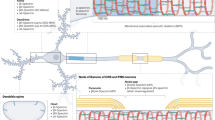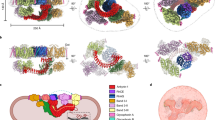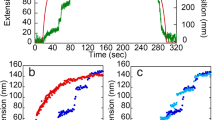Abstract
Spectrin is an αβ heterodimeric protein (molecular weight (Mr) = 460,000) which is a major component of the erythrocyte membrane skeleton1–8. The membrane skeleton also includes actin (band 5) and is attached to the membrane via non-covalent associations with two linking proteins9–12. Recently we have reported the amino acid sequence of a peptide of molecular weight 80,000 which comprises the NH2-terminal one-third of the α subunit13,14. This α-subunit peptide contains multiple homologous non-identical sequences with a periodicity of 106 amino acids and an approximate molecular weight of 12,000. It was also established that spectrin is not related to any other proteins whose sequence was known. We now report additional amino acid sequence of peptides representative of other domains of both spectrin subunits. The results suggest that most of the human erythrocyte spectrin molecule is comprised of homologous segments with a 106 amino acid (Mr 12,000) length per segment. Each homologous 106-amino acid segment may be folded into a triple helical structure with a short non-helical region connecting adjacent units.
This is a preview of subscription content, access via your institution
Access options
Subscribe to this journal
Receive 51 print issues and online access
$199.00 per year
only $3.90 per issue
Buy this article
- Purchase on Springer Link
- Instant access to full article PDF
Prices may be subject to local taxes which are calculated during checkout
Similar content being viewed by others
References
Marchesi, V. T. Blood 61, 1–11 (1983).
Haest, C. W. M. Biochim. biophys. Acta 694, 331–352 (1982).
Goodman, S. R. & Shiffer, K. Am. J. Physiol. 244, C121–C141 (1983).
Calvert, R., Bennett, P. & Gratzer, W. Eur. J. Biochem. 107, 355–361 (1980).
Ralston, G. B. Biochim. biophys. Acta 455, 163–172 (1976).
Morrow, J. S. & Marchesi, V. T. J. Cell Biol. 88, 463–468 (1981).
Zweig, S. E. & Singer, S. J. Biochem. biophys. Res. Commun. 88, 1147–1157 (1979).
Speicher, D. W. & Marchesi, V. T. J. Cell Biochem. 18, 479–492 (1982).
Ungewickell, E., Bennett, P. M., Calvert, R., Ohanian, V. & Gratzer, W. B. Nature 280, 811–814 (1979).
Cohen, C. & Branton, D. Nature 279, 163–165 (1979).
Tyler, J., Hargreaves, W. & Branton, D. Proc. natn. Acad. Sci. U.S.A. 76, 5192–5196 (1979).
Bennett, V. & Stenbuck, P. J. J. biol. Chem. 254, 2533–2541 (1979).
Speicher, D. W., Davis, G., Yurchenco, P. D. & Marchesi, V. T. J. biol. Chem. 258, 14931–14937 (1983).
Speicher, D. W., Davis, G. & Marchesi, V. T. J. biol. Chem. 258, 14938–14947 (1983).
Speicher, D. W., Morrow, J. S., Knowles, W. J. & Marchesi, V. T. J. biol. Chem. 257, 9093–9101 (1982).
Harris, H. W. Jr & Lux, S. E. J. biol. Chem. 255, 11512–11520 (1980).
Barker, W. C., Ketcham, L. K. & Dayoff, M. O. in Atlas of Protein Sequences and Structure Vol. 5, Suppl. 3 (ed. Dayhoff, M. O.) 359–362 (National Biomedical Research Foundation, Washington DC, 1978).
Schwartz, R. M. & Dayhoff, M. O. in Atlas of Protein Sequences and Structure Vol. 5, Suppl. 3 (ed. Dayhoff, M. O.) 353–358 (National Biomedical Research Foundation, Washington DC, 1978).
Schulz, G. E. & Schirmner, R. H. in Principles of Protein Structure (ed. Cantor, C. R.) 166–205 (Springer, New York, 1979).
Pink, J. R. L. in Biochemical Evolution (ed. Gutfreund, H.) 231–260 (Cambridge University Press, 1981).
Chou, P. Y. & Fasman, G. D. A. Rev. Biochem. 47, 251–276 (1978).
Chou, P. Y. & Fasman, G. D. Adv. Enzym. Related Areas molec. Biol. 47, 45–148 (1978).
Hudson, J. R. & Ralston, G. B. Biochim. biophys. Acta 535, 169–177 (1978).
Calvert, R., Ungewickell, E. & Gratzer, W. Eur. J. Biochem. 107, 363–367 (1980).
Shotten, D., Burke, B. & Branton, D. Biochim. biophys. Acta 536, 313–317 (1978).
Shotten, D., Burke, B. & Branton, D. J. molec. Biol. 181, 303–329 (1979).
Morrow, J. S., Speicher, D. W., Knowles, W. J., Hsu, C. J. & Marchesi, V. T. Proc. natn. Acad. Sci. U.S.A. 77, 6592–6596 (1980).
Speicher, D. W., Morrow, J. S., Knowles, W. J. & Marchesi, V. T. Proc. natn. Acad. Sci. U.S.A. 77, 5673–5677 (1980).
Knowles, W. J. & Bologna, M. L. Meth. Enzym. 965, 305–313 (1983).
Author information
Authors and Affiliations
Rights and permissions
About this article
Cite this article
Speicher, D., Marchesi, V. Erythrocyte spectrin is comprised of many homologous triple helical segments. Nature 311, 177–180 (1984). https://doi.org/10.1038/311177a0
Received:
Accepted:
Issue Date:
DOI: https://doi.org/10.1038/311177a0
This article is cited by
-
Mechanical Behavior of Axonal Actin, Spectrin, and Their Periodic Structure: A Brief Review
Multiscale Science and Engineering (2021)
-
Human erythrocytes: cytoskeleton and its origin
Cellular and Molecular Life Sciences (2020)
-
Multiple Functions of Spectrin: Convergent Effects
The Journal of Membrane Biology (2020)
-
Microwave & Magnetic (M2) Proteomics Reveals CNS-Specific Protein Expression Waves that Precede Clinical Symptoms of Experimental Autoimmune Encephalomyelitis
Scientific Reports (2014)
-
Intertwined αβ Spectrin Meeting Helical Actin Protofilament in the Erythrocyte Membrane Skeleton: Wrap-Around vs. Point-Attachment
Annals of Biomedical Engineering (2011)
Comments
By submitting a comment you agree to abide by our Terms and Community Guidelines. If you find something abusive or that does not comply with our terms or guidelines please flag it as inappropriate.



